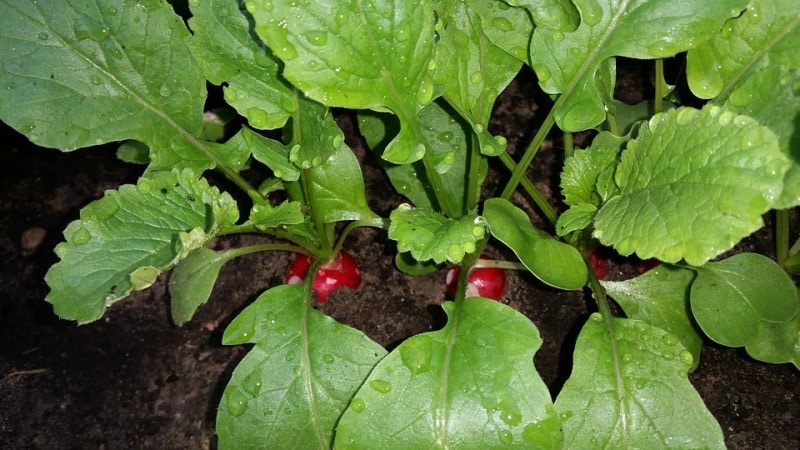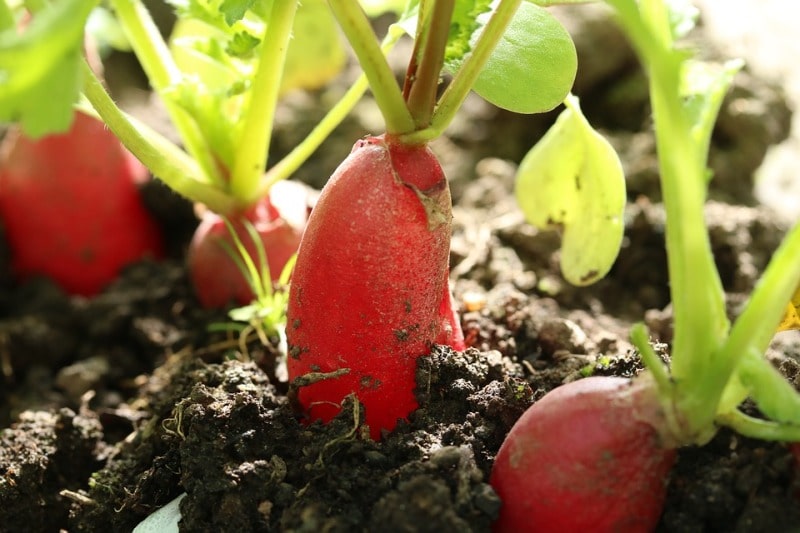A step by step guide for radish harvesting and radish plant care
Today, we discuss the radish harvesting procedure, how to take care of radish plants in the garden, and some of the facts of growing radish at home. By reading this information, one can easily understnd the importance and method of grwoing radishes on their own.
When to harvest radishes and radish harvesting steps:
- Harvesting radish on your own is not rocket science and it is an easy process.
- Radishes would be prepared for harvest when you see that their roots reach the diameter of 1 inch. Make sure that you are checking the seed packet to know your radish variety’s size when fully harvested and how much time they take to reach maturity. For harvesting, the entire plant has to be lifted out of the ground by making use of your hand.
- You can also remove any dirt and check if a bulb is grown. In that case, you will have to pull some number of radishes and then taste them. This will allow you to know if they are prepared for harvesting.
- Unlike most of the root vegetables, radishes should not be left underground, as this will make them pithy and tough.
- Make sure that you are cleaning and storing the radishes. The soil has to be brushed off from the radishes making use of your hand and then you will have to store them in a place which is cool and dark for about 15 weeks. Make sure that you are washing them with water before you are consuming them. Hope you learned about radish harvesting procedure by now.
Care and maintenance of your radish:
- You will have to manage the problems which would be caused by fungi. There are several types of fungi which will cause death to your radish or damages its taste. Generally, there are few indications of problems with fungi which you can check out for and deal with.

You may also check Growing Garlic, Planting, Care, Harvesting.
- If you see that there are grey and yellow spots on your radish leaves, there are chances that your radish is affected by leaf spot which is also called Septoria leaf spot. This is a fungal disease. If you see this, ensure that the planting bed is drained well and combine some organic matter like compost. Any radishes which are infected have to be removed. In order to eradicate this problem, the crops can be rotated so that you will not be planting the radishes in the same bed every time. Also, make sure that you are keeping your garden free from plant debris such as weeds, plants which are dead etc.
- If you see that there are pale green color spots are appearing on the upper section of the radish leaves and also a purple color growth on the lower side of the leaves, then it might be an indication that the leaves might have been affected by a type of fungus called downy mildew.
- Make sure that you are getting rid of the plants which are infected and also ensure that you are not watering the radish plants too much. Radish should not be over-crowded and this can be done by thinning the herd. In order to prevent downy mildew, ensure that you are rotating your crops and keep the garden free from the debris of the plants.
- If the leaves of the radish become yellow in color in between the veins and if the margins of the radish leaves become brown and start curling in the upward direction, of the base of the stem becomes dark brown and slimy, then these are indications that your radish has been affected by a fungal disease called blackleg. For this, you will have to go with the addition of organic matter such as compost to the plant bed and ensure that your soil is draining well by not getting hold of water because of too much watering. For avoiding this, ensure that you are rotating the crops.
- It is not only fungi which generally create problems for your radishes. There are chances for few bugs to come into your plants and start feeding on them which will, in turn, lead to the death of the plants. Most of the times, you will be able to avoid such bugs by maintaining your garden in a clear manner keeping the plant debris and weeds away. If you are seeing them even after this, here are the methods to deal with it.
- If you see that your leaves are faded and you start seeing grooves or tunnels in the radish roots, then it is an indication of root maggots. These critters are grey, tiny. These worms do not have legs. Flies are the ones which will lay eggs in the soil adjacent to the plant. For getting rid of them, go ahead with the addition of lime and wood ashes to the plant’s base. You will have to be patient for the plantation of radishes until you see that the climatic conditions are dry so that you would be able to avoid the life cycle of maggots.
- If you are seeing small holes on the leaves of radish, this is an indication of flea beetles. These tiny critters are black beetles which would have a length of 0.06 inch. If you have confirmed that you have these, you can start spreading diatomaceous earth which is a type of rock which is soft and sedimentary and will be able to crumble in an easy manner into a powder which is off-white and fine. This will also serve as a natural bug killer.
- If you see that your radish plants are having the spots which are white or yellow in color with their leaves deformed, or if you see wilting of plants, then this is an indication of Harlequin bugs. These bugs will suck the fluids from the plant tissue of the radish. These bugs have to be picked out and destroyed.
- If you see that your radish plant leaves are turning yellow in color and are curling by becoming somewhat brittle, then this is an indication that your plant has been contracted Aster yellows which is a disease which is spread by leafhoppers. In this case, you will have to take out the plants which are infected and then control the population of the leafhopper by keeping away the weeds and the debris of the plant.
- The soil type and the temperature along with the watering will play a vital role in how well your plants are doing. Keep in mind that you are watering the plants in a uniform manner by maintaining the perfect soil pH.
- If you find that the radishes are not any more tasting too pungent and hot, it is an indication that the soil is very dry or the soil temperature is too high. For the protection of your roots and cooling the soil, you can go ahead with the addition of organic mulch for at least 2 inches.
- Radishes have to be watered for every 3 hours and then be patient until the soil gets dried out up to a depth of 4 inches.
You may be interested in Growing Collard Greens, Planting, Care, Harvesting.
Facts about growing radishes:

- Radishes are simple to grow in any of the gardens irrespective of the size. They grow fast and will be prepared for harvest in about a month starting from the sowing. The radish seeds have to be sown every 15 days in the soil which is fertile and is retentive to moisture across the summer to have it in salads. Keep in mind that there are radish varieties which can be grown in winter too like Mooli.
- Plenty of nitrogen in the soil and the acidity which is neutral will also slow the process of formation of radishes. Sometimes, you will see that the radishes will not grow bulbs and the main cause for it is overcrowding. Radishes which are overcrowded will not have space they need for the production of fleshy bulbs. For this, you can thin them in such a way that there are at a distance of 2 inches from each other and this will also help in the promotion of the formation of the bulb.
- Radishes are the vegetables which are usually grown from seeds and these will sprout in about 4 days. If you are removing the top of the radish and keep it in water, it will usually give rise to more numbers of greens, but it will not lead to the creation of a radish which can be consumed. Removing the tip of the radish along with the roots and planting it in the soil which is fertile and moist will result in a new radish plant.
- Radish is a plant which loves to grow in cool seasons. This is a vegetable which can be grown easily and it also gets matured quickly. Garden radishes are the ones which can be raised wherever there is the availability of sun and the soil which is fertile and moist. Early varieties of the radish generally grow their best when the climatic conditions are cool, but few varieties which reach the maturity stage lately can be planted for harvesting at the time of summer.
- There is no requirement to water the radishes on a daily basis. They should be provided with at least 1 inch of water once a week. The soil should be kept moist making sure that you are not soaking it.
- For regrowing radishes, you can remove 1 inch of the radish from the end of the roots by making use of a knife. Then the complete cut surface of the root of the radish has to be covered in a germination gel. Then a hole has to be dug at a depth of 2 inches in the soil by making use of a garden how. Then you can start digging a row of holes which are at a distance of 2 inches from each other.
- If you have planted your radishes too late at the time of spring or too earlier at the time of autumn, then it will cause bolting.
- Once you have harvested the radishes, cut off the leafy green tops just above the spot where the stems join the roots. The roots have to be kept unwashed and have to kept in the refrigerator until you are prepared to consume them. They will be lasting up to 15 days when kept in a plastic bag which is sealed.
- Just prior to the plantation of your radishes, you will have to add some amount of all-purpose fertilizer into the soil. Apply up to ½ kg of 10-10-10 fertilizer per one square foot.
- Though sunlight is required for the growth of radish seeds, it is not required for them to undergo the process of germination. Sunlight will not cause any sort of effect on the seed germination as the seeds will be underground and the sun will not come into the picture until the radish seedling has started to grow on top of the soil.
That’s all gardeners about radish harvesting process and care. Keep gardening.!
You may be interested in Potato Cultivation in Tamilnadu, Seed Treatment, Spacing.